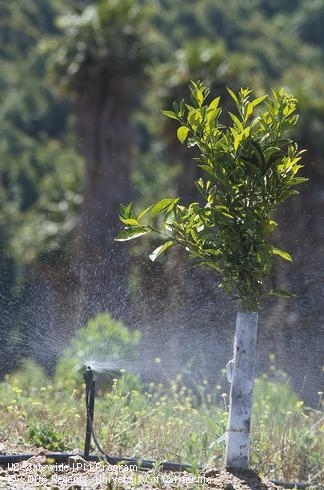How to irrigate is probably the most common question in irrigated agriculture, even with 10,000 years of cultivation knowledge to guide us. The complexities of irrigation and the unique situation for each grower makes this question so difficult. Not enough water, and plants have diminished growth or the propensity for disease and disorder 1. Too much water leads to root disease and nutrient problems 2. So, it can't be too much or too little, but just right. There are times when citrus can handle a little more water stress than other times, which can lead to water savings 3, especially in a drought year or in areas where water costs are crucial. Salinity further compounds the question of irrigation where striking a balance determines the health of your tree. Staying in tune with your orchard and using appropriate methods to measure water need, water use, environmental water demand, and soil water-holding capacity will help inform irrigation management decisions.
There are all kinds of ways of estimating tree water need 4 , a valuable piece of information for irrigation decision making. An inexpensive and often overlooked method of estimating tree water requirements is grower observation in the orchard to assess leaf color, leaf size, the look of the leaves, and canopy fullness. Pure observation and knowledge of your trees yields a lot of valuable information regarding irrigation management. Beyond observation, a direct measure of the tree with a porometer, pressure gauge (bomb), sap flow meter, dendrometer or other device gives an absolute or relative number of tree performance. Technological advances, such as telemetry and imaging with drones or satellites, holds promise, but are still being perfected for general irrigation use. In general, technological devices yield informative data, but tend to be expensive, delicate, and require manual monitoring to account for tree-to-tree variation in the orchard.
Soil moisture sensors can be an effective method of evaluating water use by the tree. The most basic way to measure soil moisture is with a human powered shovel or soil tube 5. While it requires an operator who knows what they are doing, the technique is easily learned and repeatable. A human and shovel can move around an orchard checking out different suspicious spots that are not easily done with fixed-in-place sensors. Installation of soil moisture sensors systems range in cost and capabilities, yet provide specific data on water use. Integrating certain systems into communication relay systems allow for the monitoring of multiple sites at once. Some sensors can measure soil salinity, as well as soil moisture, to give a sense of whether the water in the soil will be useable by the tree. If soil moisture sensors are used, correct placement of where roots are taking up water is imperative to get an accurate assessment of water uptake. Overall, it is critical to keep the entire orchard in mind and understand that fixed sensors only take a specific location's reading.
Another great technique to inform irrigation scheduling is an estimate of the demand that drives water use. An evapotranspiration estimate either by CIMIS, a private weather station with ET-calculation or atmometer gives not only an amount to apply but also when to apply that amount based on the water holding capacity of the soil and the rooting depth of the crop. Soil moisture holding volume can be complicated, but can be estimated from the NRCS table in the previous paragraph5 or from tables in the Web Soil Survey 7.
Simply running an irrigation system for a specific amount of time and probing for depth of water penetration and extent of wetted area is the best way to get an estimate of soil moisture holding capacity. This knowledge is needed in order to decide whether the active rooting volume is getting wetted sufficiently or too much is being applied. Emitters are rated by gallons per hour, but that 1 gph, 5 gph, 20 gph emitter output might differ according to water pressure that can vary over an irrigation period. On the flip side, monitoring soil moisture depletion over time can give an approximation of how depletion compares to ET estimates. Soil moisture depletion can be measured by soil moisture sensors or by shovel and feel. This estimate of applied water compared to output and ET only needs to be done once at a given growth stage of the orchard. If the orchards is young, it will need to be done each year as the trees fill out. An estimate of canopy growth can also be used to better approximate young orchard ET.
All of these methods suppose that a grower has the capability to irrigate when, where and for how long they need to. If water delivery is on a fixed schedule and the amount of water can be controlled it is valuable to understand specific water needs. Knowing the rated applied amount of an emitter is important, but that amount shouldn't be assumed, especially considering natural wear and tear, damage from harvest, poor filtration, clogging, or damage by wildlife. Maintenance to insure good distribution uniformity is critical to the operation and the correct application of water to trees and for the maintenance of tree health. Low-pressure systems are wonderful but they should be evaluated on a yearly basis and tuned up in preparation for every irrigation season. Many growing areas have mobile irrigation labs that will evaluate system performance and make recommendations for improvement.
All said, knowing the orchard and evaluating tree health will inform irrigation management decisions. Applying technology where technology is appropriate will help. Using it to help advise irrigation decisions is valuable, but new tools will not always be the answer.
It's important to know what is being applied.
Trust but verify.
Drought Tips & Video: https://www.youtube.com/watch?v=LKSQRuHAnYA ; https://anrcatalog.ucanr.edu/pdf/8549.pdf
Attached Images:
